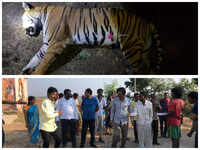Kinfra lab first tested Iron Man statue's strength
Jisha Surya | TNN | Nov 7, 2018, 14:18 IST The RWDI at Kinfra has Asia’s first commercial wind tunnel test lab
The RWDI at Kinfra has Asia’s first commercial wind tunnel test labTHIRUVANANTHAPURAM: In the attempt to attain the distinction of world's tallest statue, the newly-unveiled 'Statue of Unity' in Gujarat had to clear challenges associated with tall structures prominent of which was related to wind load. The crucial wind tunnel test of the 182-metre statue was done by a lab here in Kinfra Film and Video Park.
The office of Rowan Williams Davies & Irwin Inc (RWDI) at Kinfra has Asia's first commercial wind tunnel test lab. With the increasing demand for taller buildings, the lab is working round-the-clock to suggest necessary changes in design to reduce wind effects on highrises.
After conducting studies of renowned structures such as 'Statue of Unity', the upcoming tallest Hindu temple by ISKCON at Madurai (210 metre) and Ambedkar statue at Mumbai (110 metre), RWDI is gearing up to conduct wind tunnel test of the next big structure - the Chhatrapati Shivaji statue to come up in Mumbai, which is all set to beat the State to Unity in terms of height. The firm has conducted wind tunnel tests of over 150 highrises in the country in two years.
RWDI India managing director K Suresh Kumar said the wind tunnel being a niche field is picking up in the country. "The tests on expected wind loads must be done much before finalizing the design. Wind tunnel tests must be done on all structures with height more than 120 metre or slenderness more than 4:1. Apart from analysing wind load on tall structures, we also test aerodynamics of bridges, effect of wind velocities on pedestrians, etc.,"' he said.
The Rs 5-crore wind tunnel lab was set up at Kinfra in 2016, almost a decade after it began operations at Thejaswini building of Technopark. The wind tunnel lab will help identify intensity on wind load on the tall structures.
"For this, a scaled down, usually 1:300 times smaller model of the structure will be developed using 3D printing. Form models of all structures, including bridges and buildings within half a kilometer radius, will be recreated. The model will be set on a 360 degree rotatable disc. The lab can simulate natural wind speeds and turbulence levels with the support of two axle fans. The 3D model of the structure will have several holes which will be connected to sensors. The sensors will check the wind load on the structure," explained Rahul P S, wind engineering specialist, RWDI.
RWDI also suggests dampers for tall structures to reduce wind load. Some of the renowned examples of dampers suggested by RWDI are the 700-tonne steel ball on Taipei 101 in Taiwan, sky bridge of Petronas towers, etc.
The office of Rowan Williams Davies & Irwin Inc (RWDI) at Kinfra has Asia's first commercial wind tunnel test lab. With the increasing demand for taller buildings, the lab is working round-the-clock to suggest necessary changes in design to reduce wind effects on highrises.
After conducting studies of renowned structures such as 'Statue of Unity', the upcoming tallest Hindu temple by ISKCON at Madurai (210 metre) and Ambedkar statue at Mumbai (110 metre), RWDI is gearing up to conduct wind tunnel test of the next big structure - the Chhatrapati Shivaji statue to come up in Mumbai, which is all set to beat the State to Unity in terms of height. The firm has conducted wind tunnel tests of over 150 highrises in the country in two years.
RWDI India managing director K Suresh Kumar said the wind tunnel being a niche field is picking up in the country. "The tests on expected wind loads must be done much before finalizing the design. Wind tunnel tests must be done on all structures with height more than 120 metre or slenderness more than 4:1. Apart from analysing wind load on tall structures, we also test aerodynamics of bridges, effect of wind velocities on pedestrians, etc.,"' he said.
The Rs 5-crore wind tunnel lab was set up at Kinfra in 2016, almost a decade after it began operations at Thejaswini building of Technopark. The wind tunnel lab will help identify intensity on wind load on the tall structures.
"For this, a scaled down, usually 1:300 times smaller model of the structure will be developed using 3D printing. Form models of all structures, including bridges and buildings within half a kilometer radius, will be recreated. The model will be set on a 360 degree rotatable disc. The lab can simulate natural wind speeds and turbulence levels with the support of two axle fans. The 3D model of the structure will have several holes which will be connected to sensors. The sensors will check the wind load on the structure," explained Rahul P S, wind engineering specialist, RWDI.
RWDI also suggests dampers for tall structures to reduce wind load. Some of the renowned examples of dampers suggested by RWDI are the 700-tonne steel ball on Taipei 101 in Taiwan, sky bridge of Petronas towers, etc.






































All Comments ()+^ Back to Top
Refrain from posting comments that are obscene, defamatory or inflammatory, and do not indulge in personal attacks, name calling or inciting hatred against any community. Help us delete comments that do not follow these guidelines by marking them offensive. Let's work together to keep the conversation civil.
HIDE